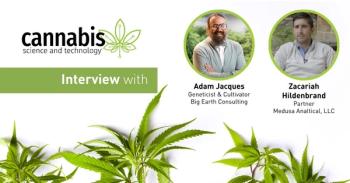
Cannabis Science and Technology
- November/December 2018
- Volume 1
- Issue 4
Setting the Standard: Considerations When Handling DEA-Exempt Cannabinoid Reference Standard Preparations Used for Potency Determination
Reference standard qualifications are discussed and techniques for qualifying incoming reference standards are suggested.
With the growth of the cannabis market, significant investments have been made into the setup, operation, and maintenance of cannabinoid potency testing laboratories. Results generated in these laboratories are not only dependent upon the accuracy of the testing methods and sample preparation, but on the quality of the reference standards from which batches of cannabis samples are directly quantified. The quality, consistency, and reliability of reference standard solutions are not only a priority for manufacturers, but it is in the best interest of testing laboratories to protect and maintain the integrity of these formulations during use and storage. In this manuscript, reference standard qualifications are discussed and techniques for qualifying incoming reference standards are suggested. Additionally, in-laboratory handling of reference solutions is explored to promote and preserve accuracy of the formulations during use.
Currently in the United States, cannabinoid isolates are classified as Schedule I controlled substances under the Controlled Substance Act (CSA) Title 21 Code of Federal Regulations (CFR) Parts 1300 to 1308. The distribution of these isolates is controlled and monitored by the Drug Enforcement Administration (DEA) division of the U.S. Department of Justice (1). Purchasing and use of controlled substances must adhere to the requirements of the Controlled Substance Act and any state enforcement agency, as well as the terms and conditions of any Institutional Research or Analytical Licenses or Registrations issued in accordance with proposed laboratory activities. Sanctioned DEA-exemptions are granted for cannabinoid preparations after approval by the DEA and Local State Codes to registered manufacturers that supply these solutions for laboratory or scientific research purposes (2).
A reference standard is broadly described by the U.S. Food and Drug Administration (FDA) and U.S. Pharmacopeia (USP) as a well characterized, highly purified compound that serves as a specimen or performance calibrator from which drug substances, excipients, impurities, degradation products, or compendial reagents are identified and quantified for purity and potency. Any material can be called a “reference standard,” but the degree to which that material is characterized defines if the reference standard is an acceptable calibrator for the intended application. Simply because DEA sanctions have been provided to a particular reference standard manufacturer, it does not automatically ensure that the reference standards produced by that manufacturer meet the quality and reliability specifications for laboratories testing cannabis samples for potency.
Certified cannabis testing laboratories operate under International Organization for Standardization (ISO) and International Electrotechnical Commission (IEC) 17025 accreditations issued by the American Association for Laboratory Accreditation (A2LA) to provide confidence that results generated in these testing laboratories are high quality and consistent. Reference standards used by these laboratories are held to the same ISO quality standard, in addition to ISO 17034:2016, which focuses specifically on an evaluation of process uncertainty. This value is associated with manufacturing as a whole, and is reported along with orthogonal testing results, in the reference standard traceable documentation (certificate of analysis [CoA]) provided as per ISO 9001:2015. These ISO accreditations offer a foundation of integrity when selecting a manufactured cannabinoid reference standard material supplier.
Evaluation of Incoming Reference Standards
Accurate determination of chromatographic purity depends upon the ability of an analytical method to resolve the analyte from closely eluted impurities. Since cannabis testing methods have yet to be standardized within the industry, the ability of chromatographic methods to separate the reference standard peak of interest from the impurities may not be consistent between laboratories. Because of this lack of standardization, chromatographic assay results determined for the reference standard solution in a sample testing laboratory may be different than the chromatographic assay value (mg/mL) reported in the CoA.
To demonstrate, three certified DEA-exempt ampouled cannabidiol (CBD) and â9-THC reference standards formulated in methanol (1.0 mg/mL) were purchased from different certified manufacturers (sources withheld). The chromatographic profiles of the CBD and â9-THC DEA-nonexempt isolate starting materials were compared to DEA-exempt ampouled reference standards using the same chromatographic platform (Figure 1) (3). (See upper right for Figure 1, click to enlarge. Figure 1: Overlay of DEA-nonexempt CBD and â9-THC isolate starting materials (black) with DEA-exempt ampouled reference standards from three manufacturers (green, red, blue) when separated using a validated chromatographic testing method for assay.)
The CBD, â9-THC isolate starting materials, and the ampouled reference standards were confirmed to be spectrally pure by ultraviolet-photodiode array (UV-PDA) detection, and the mass was confirmed by mass spectrometry (MS) using the in-house validated chromatographic method. From the linear response of a CBD isolate reference standard, the concentration of CBD in the DEA-exempt ampouled preparations was calculated and compared to the CoA. Concentrations of CBD were 1.013 mg/mL, 1.001 mg/mL, and 1.001 mg/mL. All values were within the concentration range specified by the manufacturer CoA at 1.002 ± 0.011 mg/mL, 1.002 ± 0.006 mg/mL, and 1.000 ± 0.005 mg/mL, respectively. From the concentration values, it was concluded that although the references standard solutions contained different impurities, the in-house validated method provided a comparable chromatographic separation of CBD from the impurities when compared to the chromatographic assay method used to prepare the CoA.
Only two out of the three â9-THC DEA-exempt ampouled formulations were within the concentration range reported on the respective CoA when compared to the linear regression of the â9-THC isolate. The UV-PDA spectral purity and MS response for â9-THC in the formulation and the isolate were comparable. The reference standard formulation that lies outside the CoA concentration range does not immediately imply that the manufacturer provided an inaccurate reference standard concentration assessment. It is a reminder that qualification of an incoming reference standard should not be made based upon a single testing result. In this study, results were generated for only one reference standard vial. It is recommended that replicate vials are analyzed from the same lot, and that conclusions are made based on an average concentration determination and standard deviation value for the incoming lot.
Alternatively, an evaluation of acceptability can also be made by comparing the average response factor (RF) (equation 1) of the incoming reference standard to the RF observed in the historical data for previous reference standards of the same analyte. This approach requires that cannabis testing laboratories compile average RF and concentration information over time for incoming lots, and define acceptable incoming RF tolerance limits. With this technique, it is important to use the same chromatographic separation method, confirmed to be consistent and robust over time by fulfilling method system suitability criteria (that is, recovery and resolution).
Equation 1 shows the average response factor (RF). (See upper right for Equation 1, click to enlarge.)
Preparation of Reference Standards for Sample Testing
In the testing laboratory, reference standards and sample solutions often require dilution of the initial stock solution to prepare a working standard. When working with solvent-based solutions such as cannabinoid formulations, it is important to select a pipette that will maintain accuracy. In this study, cannabinoid DEA-exempt and isolate reference standards were prepared via serial dilution using volumetric pipetting devices common in testing laboratories. Calibration curves for CBD and â9-THC were prepared using a glass volumetric pipette, an air interface pipette, and a positive-displacement syringe pipette using a 1.0-mg/mL cannabinoid reference standard formulation. Practical precautions were used to reduce error, such as using calibrated pipettes, prewetting the pipette tip with sample solution, working at a constant temperature, pipetting in a fully upright position, and avoiding transfer of the solution on the outside of the pipette tip to the collection vessel. The standard curves for linear regression were prepared to show the accuracy of each pipetting method.
Figure 2a exhibits the standard curve generated for DEA-exempt CBD reference standard using the air interface pipette. (See upper right for Figure 2, click to enlarege. Figure 2: DEA-exempt CBD reference material standard curves generated using (a) air-displacement and (b) glass volumetric or positive-displacement pipettes. Replicate curves were prepared by multiple analysts to confirm linear regression trends.) Although several of the data points in the serial dilution sequence appear to follow a linear trend, the curve was not linear by statistical regression analysis (R2 = 0.8763). There is no justification to exclude the data points that do not statistically conform to the linear regression line (y = mx + b). The results were replicated by two analysts with two different air-displacement pipettes to confirm the nonlinear trend was consistent for this type of pipette.
In contrast, for calibration curves prepared with a positive-displacement syringe pipette, or a glass volumetric pipette, the data points were repeatedly statistically linear (R2 ≥ 0.999), as demonstrated for CBD in Figure 2b.
Differences in linearity between the pipetting methods can be understood by considering the mechanism of operation and how it is impacted by the physical properties (that is, density and vapor pressure) of the solution. For example, air-displacement pipettes rely upon the movement of a piston and calibrated air-cushion to regulate the volume measurement. Upward movement of the piston produces partial vacuum in the tip, which causes a metered amount of the sample to be aspirated into the tip. The air-cushion acts like an elastic spring from which the volume of liquid in the tip is suspended (Figure 3a). (See upper right for Figure 3, click to enlarge. Figure 3: Comparison of pipetting mechanisms for (a) air-displacement and (b) positive-displacement pipettes.) The volume of the air-cushion, which varies depending on the density, vapor pressure, viscosity, and temperature of the liquid being pipetted (4,5), is most often calibrated with distilled water as the test medium. Solvents with vapor pressure different from that of water, such as those utilized for commonly used cannabinoid solvents, push against the calibrated air-cushion forcing it to expand. The aspirated solution is then displaced from the pipette tip via dripping. This phenomenon compromises the accuracy and precision of the dispensed volume (5). Additionally, commonly used solvents for cannabinoids such as methanol, ethanol, or hexane have a lower density than that of water. Thus, the volume of liquid pipetted with an air-displacement pipette is systematically high when using these solvents neat, or as a part of a mixture, if the air-cushion pipette was calibrated with water.
The physical influences that impact an air-cushion pipette are not applicable to positive-displacement or glass pipettes. These pipettes repeatedly generated serial dilutions that were statistically linear. Positive-displacement pipettes operate using an integrated piston, or internal syringe. The pipette tip is immersed in the liquid and the piston rod moves down to displace the volume of air corresponding to the desired volume of the pipetted liquid. As the piston is released, the liquid is drawn into the tip. The piston comes into direct contact with the liquid, leaving no air-space (Figure 3b). This pipetting method is suitable for both solvent-based cannabinoid reference standards and highly viscous liquids, such as extracted cannabis oils.
When using glass volumetric pipettes, although the pipetted solution comes in contact with the air-space, the meniscus is visually titrated against a volumetric calibration mark. Delivery time and waiting time determine pipetting accuracy. The delivery time is the period of time after the suction is released for the meniscus to fall from the upper volumetric mark to the pipette tip. Waiting time begins after the liquid reaches the tip and comes to rest (6). Both must be adequately used to ensure accurate pipetting, no matter the physical properties of the liquid.
Storage and In-Use Considerations
Instrumentation and consumables are the largest expense when operating a testing laboratory. Consumables are defined as items that are used for an intended purpose and must be replaced because they wear out or are used up (7). They include both reference standards and sample testing vials (8). Cannabinoid reference standards are packaged in glass ampoules sealed under inert gas to promote stability by preventing evaporation and degradation from air and light during transport (9). After the ampoule has been opened in the laboratory, a key concern is the potential for degradation during general use. A decrease in purity because of chemical degradation is always a concern, but for purposes of this manuscript, the solutions were stored before use at the temperature recommended in the package insert.
It is common practice to transfer reference standard solutions from the shipping ampoules to liquid chromatography (LC) vials for use and storage. LC vials are typically manufactured from polypropylene plastic or glass. Although polypropylene vials may be more economical, surface-treated inert glass vials can be certified as chemically clean by the manufacturer. This certification minimizes the potential for chromatographic anomalies caused by manufacturing process contamination, and is especially important for samples intended for low-level impurity analysis by mass spectrometry.
The most common closures for these LC vials are caps that snap or screw onto the vial. Snap caps provide an advantage because they are easy and fast to assemble. Glass LC vials may show imperfections because of the manufacturing process. For example, cracks in the cap may result after stretching over an opening that is too large, or for a smaller opening, the cap may not provide an adequate air seal. Both result in the escape of the solvent from the reference standard solution, resulting in an increase in the cannabinoid concentration. Although it may take a few extra seconds to secure a cap with screw threads, the threads provide adequate mechanical force to hold the septum in place and provide a consistent air seal.
There is an overwhelming variety of cap septum offerings including rubber, polyethylene, polypropylene, silicone, and polytetrafluoroethylene (PTFE). The challenge is determining which is appropriate for solvent-based cannabinoid solutions. Rubber and silicone alone are not recommended because they may express extractables and leachables when in contact with solvents. Chemically resistant polyethylene and polypropylene septa are intended for single injection, aqueous-based sample mixtures. Although polypropylene septa offer improved solvent compatibility compared to polyethylene, the piercing force is slightly higher, resulting in an increase in the probability of coring. Pure PTFE septa are not resealable and should not be used with highly volatile solvents, short cycle times, or multiple injection methods, all of which are common when testing cannabinoids. Laminated hybrid PTFE–silicone septa provide the ideal solution. A thin film of PTFE laminated to the side of the septum that faces the sample limits exposure of the silicone elastomer to the cannabinoid solvent, while the silicone on the outside surface provides resealing capability (10). Additionally, these hybrid septa are offered in a preslit format to eliminate vacuum formation or coring as it is pierced by the injection needle.
To demonstrate how quickly the reference standard solution can be affected by an inadequately sealed vial, a DEA-exempt CBD reference standard was removed from the sealed ampoule and aliquoted into two, certified, Acquity 12 x 32 mm sample manager LC vials (Waters Corporation). Both vials were sealed with screw-cap closures. One screw cap contained an inexpensive solvent-incompatible septum susceptible to coring (source withheld), and the other contained a preslit PFTE–silicone self-sealing septum (Waters). Replicate injections were performed from each vial over the course of 1.5 days while the vials were stored in the sample manager at 20 °C.
The DEA-exempt reference standard CBD concentration inside the vial that used the self-sealing PTFE–silicone septum remained stable after 1.5 days of replicate injections (Figure 4). (See upper right for Figure 4, click to enlarge. Figure 4: Plot of solution concentration for CBD reference standard stored in a vial with a degraded septum compared with a PTFE–silicon self-sealing septum.) A hole was observed in the less expensive, solvent-incompatible septum after collecting data at two injection time points. The coring resulted in evaporation of the reference standard solvent from the cannabinoid over 1.5 days, resulting in concentration of the solution. It is anticipated that a sample manager without temperature control capabilities would likely result in an even greater increase in solvent evaporation through the open septum.
It is not suggested that reference standard solutions are stored for long periods in LC vials with septum. They can be stored for longer periods in an LC vial with a chemically compatible septumless storage cap to reduce solvent loss (11). Even with this precaution, one must consider the number of times the vial is opened and closed to minimize solvent evaporation. As with incoming reference standards, the RF value can be monitored to determine if the standard is fit for use after storage based on its concentration.
Conclusions
Cannabis testing laboratories rely directly on solvent based DEA-exempt cannabinoid reference standards to accurately quantify cannabis samples. After selecting a reputable supplier, laboratories should consider adopting a qualification process for the incoming reference standards to ensure incoming formulations meet in-house assay specifications. Because cannabinoid reference standard solutions are solvent based, laboratories must be diligent when handling these formulations (that is, pipetting, vial storage) to promote integrity of the concentration from which potency determinations are established.
References:
- United States Department of Justice, Drug Enforcement Administration, Diversion Control Division. Controlled Substance Schedule: Marijuana.
https://www.deadiversion.usdoj.gov/schedules/#define . (accessed Oct 17, 2017). - United States Department of Justice, Drug Enforcement Administration 21 CFR Part 1301 [Docket No. DEA–447] “Applications to Become Registered Under the Controlled Substances Act To Manufacture Marijuana To Supply Researchers in the United States,” Federal Register, 81(156), August 12, 2016.
- C. Layton and A.J. Aubin, J. Liq. Chromatogr. Relat. Technol. 41, 114–121 (2018).
- K. Ewald, “Influence of Physical Parameters on the Dispensed Volume of Air-Cushioned Pipette,” Eppendorf User Guide No. 21. June 2015.
- K. Ewald, “Fundamentals of Dispensing,” Eppendorf User Guide No. 19. June 2015.
- “Volumetric Measurement in the Laboratory,”
www.brand.de/downloads-support/technical-information/volumetric-measurement/ . (accessed January 16, 2018). - “Consumables,”
www.Investopedia.com . (accessed June 6, 2018). - J. Witonsky, “Laboratory Spending Trends,” Lab Manager (2011).
- M. Rettinger, “Potency Claims – Only as Accurate as Your Reference Material,” Cerilliant Corporation, Emerald Conference, 2016.
- Chromatography Columns and Consumables, “Septum Selection Guide,” Thermo Scientific, 2014–2015.
- “Waters Quality Parts, Chromatography Columns and Supplies Catalog,” Waters Corporation, 2015–2016.
Catharine E. Layton and Andrew J. Aubin are with Waters Corporation in Milford, Massachusetts. Direct correspondence to:
How to Cite This Article
C.E. Layton and A.J. Aubin, Cannabis Science and Technology1(4), 22-28 (2018).
Articles in this issue
about 7 years ago
Certified Reference Material Manufacturing Challengesabout 7 years ago
Error, Accuracy, and Precisionabout 7 years ago
Supplier Profiles: Other Servicesabout 7 years ago
Supplier Profiles: Manufacturing and Processingabout 7 years ago
Supplier Profiles: Cultivation/GrowingNewsletter
Unlock the latest breakthroughs in cannabis science—subscribe now to get expert insights, research, and industry updates delivered to your inbox.




